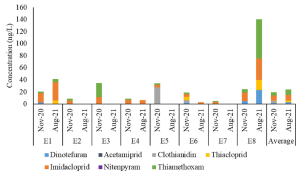Indonesia’s estuaries—where rivers meet the sea—are not just scenic coastal zones. They are rich with life, from shrimp farms and mangrove crabs to flocks of migratory birds. But a new study has sounded the alarm: a class of pesticides called neonicotinoids, widely used in rice farming, is quietly contaminating these vital ecosystems.
In a first-of-its-kind study in the country, researchers led by Zanne Sandriati Putri from the University of Tokyo and SEAMEO BIOTROP investigated estuarine waters in Indramayu, West Java—one of Indonesia’s rice powerhouses. The team discovered that 75% of water samples from local estuaries were contaminated with neonicotinoids. Two insecticides—imidacloprid and thiamethoxam—were found in the highest concentrations, with one site in the Patrol sub-district showing dangerously elevated levels.
“These pesticides are meant to kill pests, but they also harm aquatic insects and other small organisms that are the base of the food web,” said Putri.
What Are Neonicotinoids?
These synthetic insecticides, modeled after nicotine, attack insect nervous systems. They’re favored by farmers for their effectiveness, but they come with serious downsides. Neonicotinoids are water-soluble and persistent, meaning they can easily leak into rivers, linger for weeks, and travel long distances.
Originally developed in temperate regions, neonicotinoids have now spread across tropical agriculture—including Indonesia. While other countries like the EU and Canada have restricted their use due to environmental concerns, Indonesia currently has no regulations limiting neonicotinoid levels in surface water.
Why It Matters
The estuaries affected in this study are not empty wetlands—they’re ecological and economic lifelines. They support mangrove forests, over 90 bird species (including protected and migratory species), and vital aquaculture industries like shrimp farming, one of Indonesia’s top exports.
The researchers found that over 30% of samples exceeded the chronic toxicity threshold for aquatic life set by the Netherlands. Prolonged exposure, even at low doses, could weaken the immune systems of aquatic animals, reduce reproduction, or even lead to local die-offs.
Not Just a Farming Issue
Interestingly, the study found that contamination didn’t simply correlate with how large the rice fields were. Rather, the timing and proximity of pesticide application—especially during peak growing seasons like August—played a stronger role. Samples collected near active rice fields during the dry season showed the highest levels of contamination.
This suggests that even small-scale applications, if concentrated near waterways or during certain seasons, can cause significant harm.
What Can Be Done?
The study calls for urgent attention from policymakers. Indonesia lacks water quality benchmarks for neonicotinoids, leaving farmers and regulators in the dark. The authors recommend:
-
Monitoring programs in rice-growing regions
-
Risk assessments for aquaculture zones
-
Policies to reduce runoff and regulate pesticide use
“Without regulation,” the authors warn, “we risk long-term damage to our coastal biodiversity and to the food security of local communities.”
Bottom Line: What protects a rice harvest today could destroy the very waters that nourish shrimp, birds, and livelihoods tomorrow. With this new research, Indonesia has a chance to act—before it’s too late.
Putri, Z. S., Aslan, Yusmur, A., & Yamamuro, M. (2022). Neonicotinoid contamination in tropical estuarine waters of Indonesia. In Heliyon (Vol. 8, Issue 8, p. e10330). Elsevier BV. https://doi.org/10.1016/j.heliyon.2022.e10330


